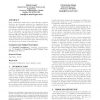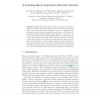86 search results - page 14 / 18 » Learning attack strategies from intrusion alerts |
SDM
2012
SIAM
11 years 10 months ago
2012
SIAM
Multiple data sources containing different types of features may be available for a given task. For instance, users’ profiles can be used to build recommendation systems. In a...
KDD
2005
ACM
14 years 8 months ago
2005
ACM
Many classification tasks, such as spam filtering, intrusion detection, and terrorism detection, are complicated by an adversary who wishes to avoid detection. Previous work on ad...
FC
2010
Springer
13 years 11 months ago
2010
Springer
Despite the conventional wisdom that proactive security is superior to reactive security, we show that reactive security can be competitive with proactive security as long as the r...
RAID
2009
Springer
14 years 2 months ago
2009
Springer
Because of the ad hoc nature of web applications, intrusion detection systems that leverage machine learning techniques are particularly well-suited for protecting websites. The re...
FOCS
2007
IEEE
14 years 2 months ago
2007
IEEE
We introduce a new primitive called Intrusion-Resilient Secret Sharing (IRSS), whose security proof exploits the fact that there exist functions which can be efficiently computed ...



